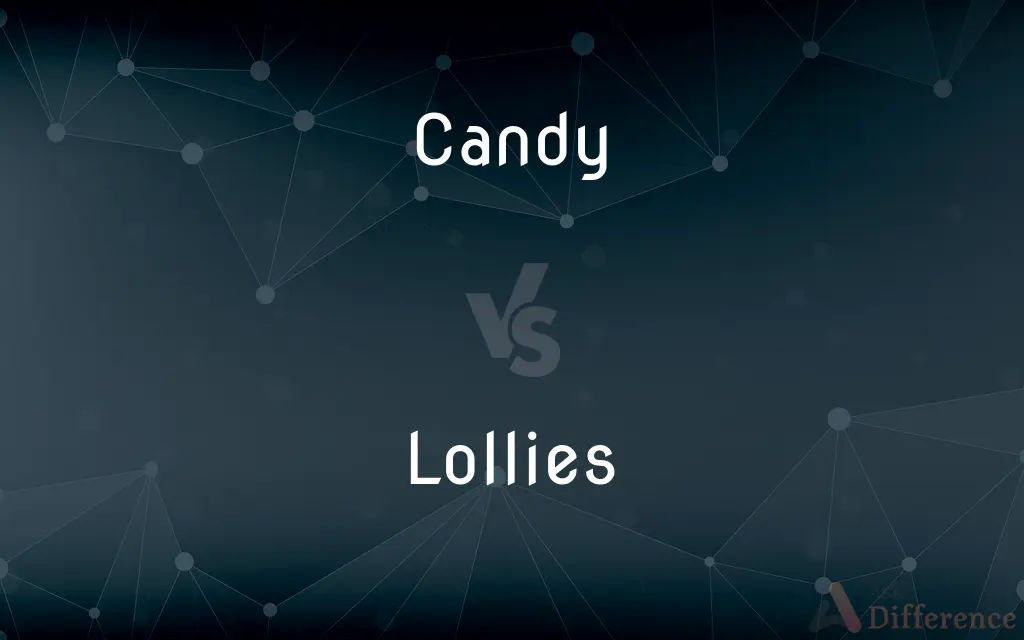Candy vs. Lollies — What's the Difference?
Edited by Tayyaba Rehman — By Fiza Rafique — Updated on March 29, 2024
Candy is a broad term for sweet confections in the U.S., while lollies specifically refer to sugary treats on a stick in the U.S. but means all candies in Australia and New Zealand.

Difference Between Candy and Lollies
Table of Contents
ADVERTISEMENT
Key Differences
Candy, in American English, encompasses a wide range of sweet confections, including chocolates, gummies, and hard candies. On the other hand, the term lollies in the United States specifically refers to sweets on a stick, commonly known as lollipops. However, in countries like Australia and New Zealand, lollies have a broader meaning, akin to the American use of candy, including various types of sweets, not limited to those on a stick.
The ingredients of candy can vary widely, from chocolate and fruit flavors to mint and licorice, depending on the type of confection. Whereas lollies, in the context of lollipops, often consist of hard candy on a stick, flavored with fruit or other sweet flavors, the Australian and New Zealand usage of lollies includes a similar variety of ingredients to American candies.
Candy is usually categorized by its texture and type, such as hard candy, gummies, or chocolate. Lollies, when referring to lollipops, are categorized by their form factor (on a stick) but, in Australasian usage, also encompass a range of textures and types, including those found in American candies.
The cultural context of candy is significant in the United States, with holidays like Halloween and Christmas often celebrated with specific candies. Lollies, in both the American and Australasian contexts, are associated with children's parties and celebrations, but in Australia and New Zealand, lollies play a similar cultural role to candy in the United States.
Marketing and packaging of candy in the U.S. are designed to appeal to a broad audience, including both children and elders, with colorful packaging and various flavors. Lollies, especially lollipops in the U.S., often feature whimsical designs and are marketed towards children, while in Australia and New Zealand, lollies are marketed similarly to how candies are in the United States, with a broad appeal.
ADVERTISEMENT
Comparison Chart
Definition
Broad term for sweet confections
Sweets on a stick in the U.S., all candies in Australia and New Zealand
Ingredients
Varies (chocolate, fruit, mint)
Primarily hard candy for lollipops; varies in Australia and New Zealand
Types
Hard candies, gummies, chocolate
On a stick in the U.S.; includes American candy types in Australasia
Cultural Significance
Celebrated with holidays
Associated with children's parties, similar cultural significance in Australasia
Marketing
Broad appeal, colorful packaging
Whimsical designs for lollipops, broad appeal in Australasia
Compare with Definitions
Candy
Often consumed as a treat or used to celebrate holidays and special occasions.
The candy cane is a traditional candy associated with Christmas.
Lollies
In the U.S., specifically means sweets on a stick, such as lollipops.
For the school party, she brought a pack of fruit-flavored lollies.
Candy
Can be homemade or commercially produced, available in a wide range of flavors.
She enjoys making homemade candy, especially chocolate truffles.
Lollies
Refers to lollipops or all candies in Australasia, typically sweet and flavored.
The children were excited to get lollies at the parade.
Candy
A sweet confection made with sugar and often flavored or combined with fruits, nuts, or chocolate.
She bought a bag of candy to share with her friends.
Lollies
Lollies are often associated with children's parties and celebratory events.
The birthday goody bags were filled with assorted lollies.
Candy
Packaging and marketing of candy are designed to appeal to both children and elders.
The bright and colorful packaging of the candy caught his eye at the store.
Lollies
In Australia and New Zealand, encompasses a wide range of candies including chocolates, gummies, and hard candies.
At the cinema, they chose a variety of lollies from the candy bar.
Candy
Candy can be classified into various types, such as hard candy, gummies, and chocolate bars.
For Halloween, they gave out assorted candies including gummies and chocolate bars.
Lollies
Marketing of lollies in Australasia targets a broad audience, similar to candies in the U.S.
The advertisement for the new range of lollies featured a colorful and fun design.
Candy
Candy, also called sweets (British English) or lollies (Australian English, New Zealand English), is a confection that features sugar as a principal ingredient. The category, called sugar confectionery, encompasses any sweet confection, including chocolate, chewing gum, and sugar candy.
Lollies
A piece of candy, especially hard candy.
Candy
A rich sweet confection made with sugar and often flavored or combined with fruits or nuts.
Lollies
A lollipop.
Candy
A piece of such a confection.
Candy
(Slang) An illicit drug, especially one, such as cocaine, that has a sugary appearance or a drug in pill form, such as MDMA.
Candy
To cook, preserve, saturate, or coat with sugar or syrup
Candy apples.
Candy ginger.
Candy
Edible, sweet-tasting confectionery containing sugar, or sometimes artificial sweeteners, and often flavored with fruit, chocolate, nuts, herbs and spices, or artificial flavors.
Candy
A piece of confectionery of this kind.
Candy
Crack cocaine.
Candy
(uncountable) An accessory (bracelet, etc.) made from pony beads, associated with the rave scene.
Candy kid; candy raver
Candy
(obsolete) A unit of mass used in southern India, equal to twenty maunds, roughly equal to 500 pounds avoirdupois but varying locally.
Candy
(cooking) To cook in, or coat with, sugar syrup.
Candy
(intransitive) To have sugar crystals form in or on.
Fruits preserved in sugar candy after a time.
Candy
(intransitive) To be formed into candy; to solidify in a candylike form or mass.
Candy
To conserve or boil in sugar; as, to candy fruits; to candy ginger.
Candy
To make sugar crystals of or in; to form into a mass resembling candy; as, to candy sirup.
Candy
To incrust with sugar or with candy, or with that which resembles sugar or candy.
Those frosts that winter bringsWhich candy every green.
Candy
To have sugar crystals form in or on; as, fruits preserved in sugar candy after a time.
Candy
To be formed into candy; to solidify in a candylike form or mass.
Candy
Any sweet, more or less solid article of confectionery, especially those prepared in small bite-sized pieces or small bars, having a wide variety of shapes, consistencies, and flavors, and manufactured in a variety of ways. It is often flavored or colored, or covered with chocolate, and sometimes contains fruit, nuts, etc.; it is often made by boiling sugar or molasses to the desired consistency, and than crystallizing, molding, or working in the required shape. Other types may consist primarily of chocolate or a sweetened gelatin. The term may be applied to a single piece of such confection or to the substance of which it is composed.
Candy
Cocaine.
Candy
A weight, at Madras 500 pounds, at Bombay 560 pounds.
Candy
A rich sweet made of flavored sugar and often combined with fruit or nuts
Candy
Coat with something sweet, such as a hard sugar glaze
Common Curiosities
Can lollies include gummy candies?
Yes, in Australia and New Zealand, gummy candies are included under lollies.
Are chocolates considered candy or lollies?
Chocolates are considered candy in the U.S. and can be classified as lollies in Australia and New Zealand.
Is candy only for children?
No, candy is enjoyed by people of all ages, though it is often marketed heavily towards children.
What are some examples of candy?
Examples include chocolate bars, gummy bears, and hard candies like peppermints.
Do candy and lollies have different ingredients?
The ingredients can vary, but both can include sugar, fruit flavors, and chocolate among others.
What is the main difference between candy and lollies?
Candy is a general term for sweet treats in the U.S., while lollies refer to sweets on a stick in the U.S. but all candies in Australia and New Zealand.
What's a popular type of lolly in Australia?
Popular types include jelly beans, licorice, and chocolate freckles.
How are lollies packaged differently in Australia compared to the U.S.?
In Australia, lollies, like candies in the U.S., are packaged to appeal to a broad audience with colorful designs.
How do celebrations influence the consumption of candy and lollies?
Celebrations and holidays significantly boost the consumption of both, with specific treats associated with certain events.
Are there specific holidays associated with candy consumption in the U.S.?
Yes, holidays like Halloween and Easter are particularly associated with candy consumption.
Can lollies be homemade?
Yes, lollies, like candies, can be homemade, especially varieties like chocolate lollies or simple hard candies.
Why are lollipops considered lollies in the U.S.?
Lollipops are considered lollies due to their specific form factor of being sweets on a stick.
How do cultural perceptions of candy and lollies differ internationally?
Cultural perceptions vary, with lollies in Australasia encompassing what Americans consider candy, reflecting broader definitions.
Is there a nutritional difference between candy and lollies?
Nutritionally, both are high in sugar, though the specific content can vary based on ingredients like chocolate or fruit.
What distinguishes hard candy from other types of candy?
Hard candy is defined by its solid, crystallized sugar base without fillers, differing from chocolates or gummies.
Share Your Discovery

Previous Comparison
Paramedic vs. Ambulance
Next Comparison
Skipt vs. SkipAuthor Spotlight
Written by
Fiza RafiqueFiza Rafique is a skilled content writer at AskDifference.com, where she meticulously refines and enhances written pieces. Drawing from her vast editorial expertise, Fiza ensures clarity, accuracy, and precision in every article. Passionate about language, she continually seeks to elevate the quality of content for readers worldwide.
Edited by
Tayyaba RehmanTayyaba Rehman is a distinguished writer, currently serving as a primary contributor to askdifference.com. As a researcher in semantics and etymology, Tayyaba's passion for the complexity of languages and their distinctions has found a perfect home on the platform. Tayyaba delves into the intricacies of language, distinguishing between commonly confused words and phrases, thereby providing clarity for readers worldwide.
















































